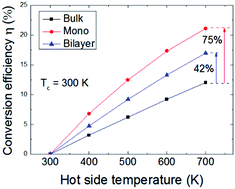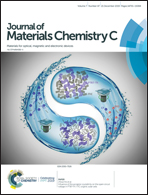Significant enhancement in the thermoelectric performance of Bi2O2S through dimensionality reduction†
Abstract
Nano-engineered technology has been applied in thermoelectrics for the enhanced performance owing to the substantial thermal conductivity reduction. Based on density functional theory, the electronic and phonon transport properties of the Bi2O2S bulk and two-dimensional (2D) nano-thin film are systematically studied. Due to the typical layered structure, the thermoelectric properties of bismuth chalcogenides Bi2O2S vary greatly along different axes showing strong anisotropy. It was found that the dimensionality reduction in the Bi2O2S bulk could not only avoid the poor thermoelectric effect in the interlayer direction, but also notably reduce the intralayer lattice thermal conductivity from the bulk value of 2.9 W m−1 K−1 to nearly 1.85 W m−1 K−1 at 300 K. The average ZT value of the Bi2O2S monolayer could reach 3.4 at 700 K. Meanwhile, the thermoelectric conversion efficiency of the nano-thin film could be improved by 75% compared with that of the bulk material. Our theoretical results prove that low-dimensional nanostructure technology could be an effective approach to enhance the thermoelectric conversion efficiency of materials.



 Please wait while we load your content...
Please wait while we load your content...